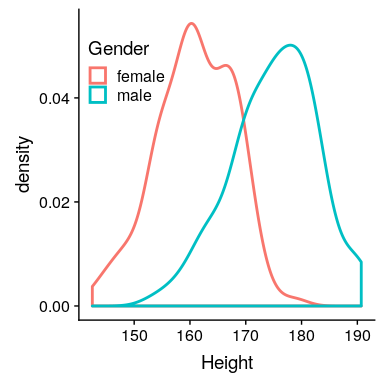## 10.2 效果大小
> “統計顯著性是最不有趣的結果。你應該用數量尺度來描述結果——不僅僅是治療對人有影響,還有它對人有多大的影響。”基因玻璃(Ref)
在最后一章中,我們討論了統計學意義不一定反映實際意義的觀點。為了討論實際意義,我們需要一種標準的方法來根據實際數據描述效應的大小,我們稱之為 _ 效應大小 _。在本節中,我們將介紹這個概念,并討論計算影響大小的各種方法。
效應大小是一種標準化的測量,它將某些統計效應的大小與參考量(如統計的可變性)進行比較。在一些科學和工程領域中,這個概念被稱為“信噪比”。有許多不同的方法可以量化效果大小,這取決于數據的性質。
### 10.2.1 科恩
影響大小最常見的度量之一是以統計學家雅各布·科恩(Jacob Cohen)的名字命名的 _ 科恩的 D_,他在 1994 年發表的題為“地球是圓的(P<;.05)”的論文中最為著名。它用于量化兩種方法之間的差異,根據它們的標準偏差:

其中和是兩組的平均值,而是合并標準偏差(這是兩個樣本的標準偏差的組合,由樣本大小加權):

其中和是樣品尺寸,和分別是兩組的標準偏差。
有一個常用的尺度可以用科恩的 D 來解釋效應的大小:
<colgroup><col style="width: 8%"> <col style="width: 22%"></colgroup>
| D | 解釋 |
| --- | --- |
| 0.2 條 | 小的 |
| 0.5 倍 | 中等的 |
| 0.8 倍 | 大的 |
觀察一些常見的理解效果,有助于理解這些解釋。
```r
# compute effect size for gender difference in NHANES
NHANES_sample <-
NHANES_adult %>%
drop_na(Height) %>%
sample_n(250)
hsum <-
NHANES_sample %>%
group_by(Gender) %>%
summarize(
meanHeight = mean(Height),
varHeight = var(Height),
n = n()
)
#pooled SD
s_height_gender <- sqrt(
((hsum$n[1] - 1) * hsum$varHeight[1] + (hsum$n[2] - 1) * hsum$varHeight[2]) /
(hsum$n[1] + hsum$n[2] - 2)
)
#cohen's d
d_height_gender <- (hsum$meanHeight[2] - hsum$meanHeight[1]) / s_height_gender
sprintf("Cohens d for male vs. female height = %0.2f", d_height_gender)
```
```r
## [1] "Cohens d for male vs. female height = 1.95"
```
參照上表,身高性別差異的影響大小(d=1.95)很大。我們也可以通過觀察樣本中男性和女性身高的分布來看到這一點。圖[10.2](#fig:genderHist)顯示,這兩個分布雖然仍然重疊,但分離得很好,突出了這樣一個事實:即使兩個組之間的差異有很大的影響大小,每個組中的個體也會更像另一個組。

圖 10.2 nhanes 數據集中男性和女性身高的平滑柱狀圖,顯示了明顯不同但明顯重疊的分布。
同樣值得注意的是,我們很少在科學中遇到這種規模的影響,部分原因是它們是如此明顯的影響,以至于我們不需要科學研究來找到它們。正如我們將在第[17](#doing-reproducible-research)章中看到的那樣,在科學研究中報告的非常大的影響往往反映出有問題的研究實踐的使用,而不是自然界中真正的巨大影響。同樣值得注意的是,即使有如此巨大的影響,這兩種分布仍然是重疊的——會有一些女性比普通男性高,反之亦然。對于最有趣的科學效應來說,重疊的程度會大得多,所以我們不應該馬上就基于一個大的效應大小得出關于不同人群的強有力的結論。
### 10.2.2 皮爾遜 R
Pearson 的 _r_ 也稱為 _ 相關系數 _,是對兩個連續變量之間線性關系強度的度量。我們將在[13](#modeling-continuous-relationships)章中更詳細地討論相關性,因此我們將保存該章的詳細信息;這里,我們簡單地介紹 _r_ 作為量化兩個變量之間關系的方法。
_r_ 是一個在-1 到 1 之間變化的度量值,其中值 1 表示變量之間的完全正關系,0 表示沒有關系,而-1 表示完全負關系。圖[10.3](#fig:corrFig)顯示了使用隨機生成的數據的各種相關級別的示例。

圖 10.3 不同水平皮爾遜 R 的示例。
### 10.2.3 優勢比
在我們之前關于概率的討論中,我們討論了概率的概念——也就是說,某些事件發生與未發生的相對可能性:

優勢比只是兩個優勢比。例如,讓我們以吸煙和肺癌為例。2012 年發表在《國際癌癥雜志》上的一項研究(Pesch 等人 2012 年)關于吸煙者和從未吸煙的個體肺癌發生率的綜合數據,通過許多不同的研究。請注意,這些數據來自病例對照研究,這意味著這些研究的參與者之所以被招募,是因為他們要么患了癌癥,要么沒有患癌癥;然后檢查他們的吸煙狀況。因此,這些數字并不代表一般人群中吸煙者的癌癥患病率,但它們可以告訴我們癌癥與吸煙之間的關系。
```r
# create table for cancer occurrence depending on smoking status
smokingDf <- tibble(
NeverSmoked = c(2883, 220),
CurrentSmoker = c(3829, 6784),
row.names = c("NoCancer", "Cancer")
)
pander(smokingDf)
```
<colgroup><col style="width: 19%"> <col style="width: 22%"> <col style="width: 15%"></colgroup>
| 從不吸煙 | 當前吸煙者 | 行名稱 |
| --- | --- | --- |
| 2883 個 | 3829 年 | 無癌癥者 |
| 220 | 6784 個 | 癌癥 |
我們可以將這些數字轉換為每個組的優勢比:
```r
# convert smoking data to odds
smokingDf <-
smokingDf %>%
mutate(
pNeverSmoked = NeverSmoked / sum(NeverSmoked),
pCurrentSmoker = CurrentSmoker / sum(CurrentSmoker)
)
oddsCancerNeverSmoked <- smokingDf$NeverSmoked[2] / smokingDf$NeverSmoked[1]
oddsCancerCurrentSmoker <- smokingDf$CurrentSmoker[2] / smokingDf$CurrentSmoker[1]
```
從未吸煙的人患肺癌的幾率為 0.08,而目前吸煙者患肺癌的幾率為 1.77。這些比值告訴我們兩組患者患癌癥的相對可能性:
```r
#compute odds ratio
oddsRatio <- oddsCancerCurrentSmoker/oddsCancerNeverSmoked
sprintf('odds ratio of cancer for smokers vs. nonsmokers: %0.3f',oddsRatio)
```
```r
## [1] "odds ratio of cancer for smokers vs. nonsmokers: 23.218"
```
23.22 的比值比告訴我們,吸煙者患癌癥的幾率大約是不吸煙者的 23 倍。
- 前言
- 0.1 本書為什么存在?
- 0.2 你不是統計學家-我們為什么要聽你的?
- 0.3 為什么是 R?
- 0.4 數據的黃金時代
- 0.5 開源書籍
- 0.6 確認
- 1 引言
- 1.1 什么是統計思維?
- 1.2 統計數據能為我們做什么?
- 1.3 統計學的基本概念
- 1.4 因果關系與統計
- 1.5 閱讀建議
- 2 處理數據
- 2.1 什么是數據?
- 2.2 測量尺度
- 2.3 什么是良好的測量?
- 2.4 閱讀建議
- 3 概率
- 3.1 什么是概率?
- 3.2 我們如何確定概率?
- 3.3 概率分布
- 3.4 條件概率
- 3.5 根據數據計算條件概率
- 3.6 獨立性
- 3.7 逆轉條件概率:貝葉斯規則
- 3.8 數據學習
- 3.9 優勢比
- 3.10 概率是什么意思?
- 3.11 閱讀建議
- 4 匯總數據
- 4.1 為什么要總結數據?
- 4.2 使用表格匯總數據
- 4.3 分布的理想化表示
- 4.4 閱讀建議
- 5 將模型擬合到數據
- 5.1 什么是模型?
- 5.2 統計建模:示例
- 5.3 什么使模型“良好”?
- 5.4 模型是否太好?
- 5.5 最簡單的模型:平均值
- 5.6 模式
- 5.7 變異性:平均值與數據的擬合程度如何?
- 5.8 使用模擬了解統計數據
- 5.9 Z 分數
- 6 數據可視化
- 6.1 數據可視化如何拯救生命
- 6.2 繪圖解剖
- 6.3 使用 ggplot 在 R 中繪制
- 6.4 良好可視化原則
- 6.5 最大化數據/墨水比
- 6.6 避免圖表垃圾
- 6.7 避免數據失真
- 6.8 謊言因素
- 6.9 記住人的局限性
- 6.10 其他因素的修正
- 6.11 建議閱讀和視頻
- 7 取樣
- 7.1 我們如何取樣?
- 7.2 采樣誤差
- 7.3 平均值的標準誤差
- 7.4 中心極限定理
- 7.5 置信區間
- 7.6 閱讀建議
- 8 重新采樣和模擬
- 8.1 蒙特卡羅模擬
- 8.2 統計的隨機性
- 8.3 生成隨機數
- 8.4 使用蒙特卡羅模擬
- 8.5 使用模擬統計:引導程序
- 8.6 閱讀建議
- 9 假設檢驗
- 9.1 無效假設統計檢驗(NHST)
- 9.2 無效假設統計檢驗:一個例子
- 9.3 無效假設檢驗過程
- 9.4 現代環境下的 NHST:多重測試
- 9.5 閱讀建議
- 10 置信區間、效應大小和統計功率
- 10.1 置信區間
- 10.2 效果大小
- 10.3 統計能力
- 10.4 閱讀建議
- 11 貝葉斯統計
- 11.1 生成模型
- 11.2 貝葉斯定理與逆推理
- 11.3 進行貝葉斯估計
- 11.4 估計后驗分布
- 11.5 選擇優先權
- 11.6 貝葉斯假設檢驗
- 11.7 閱讀建議
- 12 分類關系建模
- 12.1 示例:糖果顏色
- 12.2 皮爾遜卡方檢驗
- 12.3 應急表及雙向試驗
- 12.4 標準化殘差
- 12.5 優勢比
- 12.6 貝葉斯系數
- 12.7 超出 2 x 2 表的分類分析
- 12.8 注意辛普森悖論
- 13 建模持續關系
- 13.1 一個例子:仇恨犯罪和收入不平等
- 13.2 收入不平等是否與仇恨犯罪有關?
- 13.3 協方差和相關性
- 13.4 相關性和因果關系
- 13.5 閱讀建議
- 14 一般線性模型
- 14.1 線性回歸
- 14.2 安裝更復雜的模型
- 14.3 變量之間的相互作用
- 14.4“預測”的真正含義是什么?
- 14.5 閱讀建議
- 15 比較方法
- 15.1 學生 T 考試
- 15.2 t 檢驗作為線性模型
- 15.3 平均差的貝葉斯因子
- 15.4 配對 t 檢驗
- 15.5 比較兩種以上的方法
- 16 統計建模過程:一個實例
- 16.1 統計建模過程
- 17 做重復性研究
- 17.1 我們認為科學應該如何運作
- 17.2 科學(有時)是如何工作的
- 17.3 科學中的再現性危機
- 17.4 有問題的研究實踐
- 17.5 進行重復性研究
- 17.6 進行重復性數據分析
- 17.7 結論:提高科學水平
- 17.8 閱讀建議
- References
